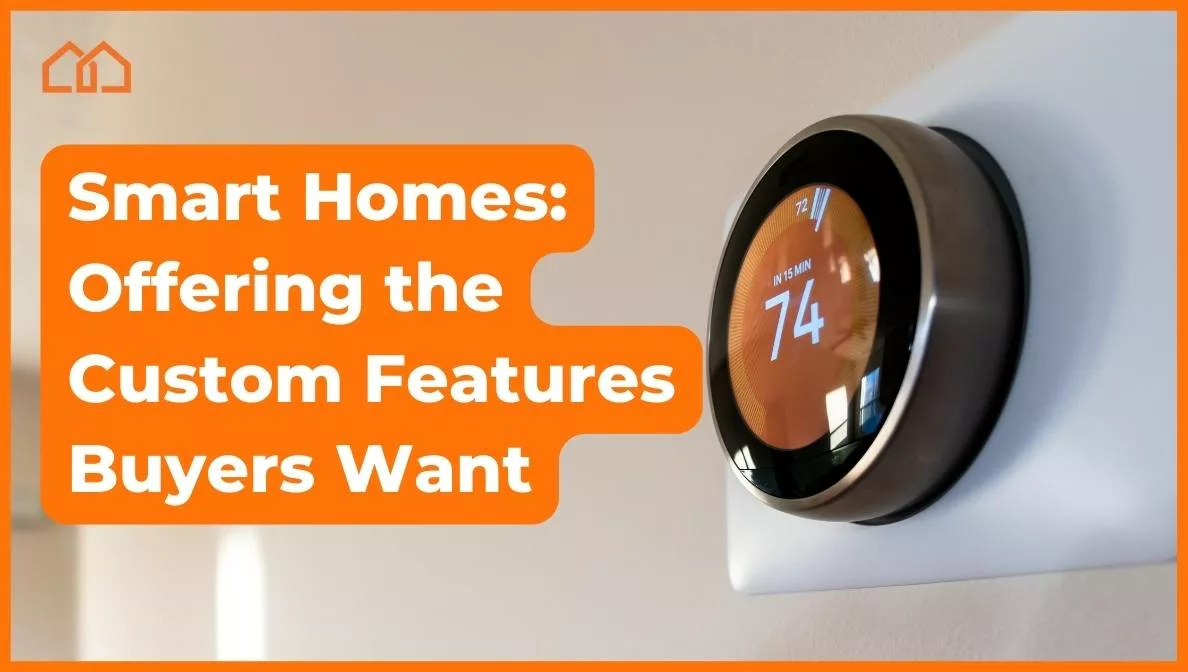Did you know that almost half of U.S. households (46.5%, o4 60.4 million) use smart home devices? From the convenience of Ring doorbells to automated cooking devices, Americans from sea to sea are falling in love with home automation. And, just five years ago, 29.5 million households were using smart home tech, which is almost half the number today. This serious growth shows that this trend is here to stay – and that smart homes are the future.
This presents another opportunity for builders of new construction homes to create the modern home of a person’s dreams. What was once a novelty is no longer an option, but it’s a marketable, desirable feature expected in new homes. If you’re a builder looking to offer the best of the best, priming a new construction for a smart home system can increase your market appeal.
You can also save more new construction deals when you partner with Marketplace Homes. We offer excellent commission discounts and buyout options to make the buying process as streamlined and convenient as possible.
What’s a Smart Home?
A smart home is a hardwired or wireless setup where a user can control any fixture, device, or appliance from a hub. This can be through a networked device within the home or via an app on a phone or tablet. In a smart home, users can control a variety of functions, such as:
- Security systems
- Thermostats
- Lighting
- Home theater
- Appliances
- Door locks
- Sound systems
- Shades
- Garage door operation
Automating these parts of the home doesn’t just make life simpler, but it can save homeowners on energy costs. Though older homes can get plenty of retroactive “a la carte” smart devices, such as an automated thermostat, new homes can be optimized for smart home technology during the building process.
This enables the new build to be well-suited for hardwired automation hubs, which avoids many security risks and bugs associated with wifi-controlled home automation. Such a full-scale project does have a sizable upfront cost, but the benefits of higher security outweigh the upfront investment.
What can you put in a smart home?
When it comes to smart home technology, if you can dream it, you can probably do it. Established brands and startups are coming out with so many innovations that it’s frankly hard to keep up. There are also many that you may not ever try, but they exist to serve specific niches, such as a bluetooth fork that monitors your eating speed.
But when it comes to a new build, buyers will typically focus on the big-ticket automation like lighting, shades, garage openers, door locks, security systems, thermostats, and appliances. Having the essentials set up by moving day makes their new home all the better.
Wi-Fi vs. Hardwired Systems
We briefly talked about how Wi-Fi smart home systems have more risk than hardwired. Though these are more vulnerable to hacks and bugs, it’s not the end of the world to include them in a new build. Some buyers may want the convenience of a few features without committing to hardwiring, while others want everything controlled from one hardwired hub for long-term convenience. You may also use a combination of hardwired and Wi-Fi systems if you add new devices after move-in day.
Hardwired System Pros:
- Everything is set up professionally and is operated from the same hub. No different apps or devices to juggle.
- More difficult to hack or be affected by bugs that hamper performance.
- You can control everything through local connectivity, so if the Wi-Fi goes out, you still have total control.
- Excellent for larger homes and new builds.
- Overall, more reliable.
- Increases resale value of the home.
- It can be easily scaled, so it’s the default system for a new build or renovation.
Hardwired System Cons:
- Costs a lot more to install initially.
- Requires wiring prep to optimize its performance, making it tougher to install in complete homes.
- It can be difficult to change your system if you want a change of pace.
Wi-Fi System Pros:
- More affordable than hardwired systems.
- Are a-la-carte, enabling mix-and-match solutions.
- Usually doesn’t need expensive wiring.
- Easier to install.
- Excellent for smaller, existing homes.
Wi-Fi System Cons:
- More susceptible to bugs and hackers.
- When Wi-Fi cuts out, you use operative power.
- You also need strong Wi-Fi coverage and broadband, which can cause you to buy expensive internet and boosters.
As you can see, offering the option to optimize a new build plan to include a local smart home system can offer a lot of value to your buyers. The presence of a hardwired, reliable smart home system also makes a property more desirable and valuable.
How to Plan for a Smart Home
While there are many ways to retroactively install a smart home system through Wi-Fi, buyers who know they want a smart home system can take proactive steps. Builders can fulfill the buyer’s wishes by establishing a pre-wiring foundation that makes it far easier to install a local automated home system that doesn’t fail when the internet cuts out. It’s up to builders to find a smart home partner that will offer the best solutions.
Buyers may also suggest systems that they prefer and collaborate during the planning process to make their vision work beyond the blueprint. Overall, every builder has tried-and-true processes for planning and executing plans, and integrating smart home systems is another valuable feature to include in today’s new builds. By working with home automation partners, contractors, and other business affiliates, everyone can unite their dreams to an actuated plan that works.
How to Make a Smart Home New Construction Contract
If you want to offer your clients the option of smart tech with their new build, then you have come to the right place. Marketplace Homes is an expert at connecting buyers to builders through our unique incentive programs that eliminate barriers to new construction. Contact us today to find out how we can strengthen deals and incentivize new builds for your clients.
Alicia Persson is a Content Strategist SEO writer at Marketplace Homes, utilizing previous years of experience on real estate teams that specialized in investments and property management. Before she joined Marketplace Homes, she was also a freelance writer for 7 years, leading to a specialization in real estate and home living content for boutique digital marketing agencies. During her writing years, she learned the basics of SEO and gained experience writing for many different clients, making her versatile at creating diverse content.
She is a proud University of Virginia master’s graduate and enjoyed her undergraduate years at the University of Mary Washington. When Alicia is not writing, she plays keytar and sings in a local 90’s rock cover band, or she spends time with her amazing family.


